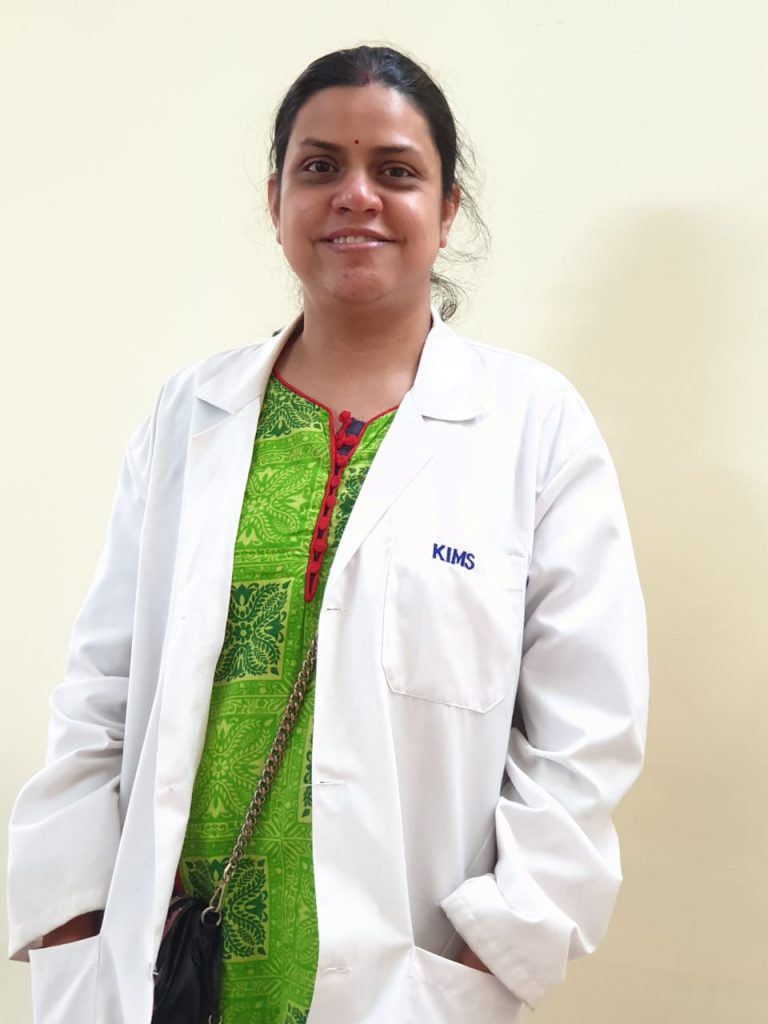Child with Upper Gastrointestinal Bleed Treated Successfully at KIMS
Upper Gastrointestinal Bleed (UGIB) is a life threatening medical emergency in children. Children classically present with hematemesis, though rarely they may present with melena. The etiology of UGIB in children is diverse and varies on age of the child. UGIB is extremely rare in infants.

A 49-day old male infant, belonging to low socioeconomic class from Dhenkanal was referred to KIMS with a history of progressive pallor and passage of dark tarry stool for 20 days. There was no history of hematemesis or of bleeding from any other sites of the body. He was born at term by vaginal delivery without any intra-partum or postpartum complications. He was exclusively formula fed. There was no history suggestive of congenital coagulation factor deficiency. He was admitted in a local hospital where he had hemoglobin level of 3.9 gm/dL, total leukocyte count of 13160/mL. He had marked peripheral eosinophilia with Absolute Eosinophil Count (AEC) of 4140/mL. His coagulation parameters, liver function and renal functions were normal. Stool routine and microscopic examination, didn’t show any ova, cyst or parasites. He received parenteral Vitamin-K, multiple packed red blood cells and fresh frozen plasma transfusions. However, melena persisted and he was referred for pediatric hematology consultation to Dr. Palash Das, Assistant Professor, Department of Pediatrics, KIMS.

At admission, the child was lethargic and pale. Abdominal examination showed mild splenomegaly. The rest of general and systemic examinations were normal. He had hemoglobin level of 6 gm/dL, total leukocyte count of 10700/mL. He had marked peripheral eosinophilia with AEC of 1100/mL. Ultrasonography of abdomen and doppler study of portal venous system were essentially normal except for mild splenomegaly. He was started on intravenous pantoprazole infusion, antibiotics and multivitamins. Stool examination was repeated and was negative for ova and cysts. In view of persistent melena, upper gastrointestinal endoscopy (UGIE) was planned.
Upper GI endoscopy is a difficult procedure in such a small baby. However, KIMS Department of Gastroenterology and Hepatology came to rescue and did endoscopy under sedation using Olympus ultrathin gastroscope (GIF-XP290N) which to our surprise showed multiple hookworms (Ancylostoma duodenale) adhering to mucosae of first and second part of duodenum (Figure-1). Few erosions were also seen in duodenum.
Child was treated with a single dose (200 mg) of albendazole. Three days after treatment he started passing normal yellow pigmented stools along with dead worms. Hemoglobin levels also improved to 10 g/dL and remained stable.
Parents were extremely thankful for the diagnosis. They had received 10 units of packed RBC and 6 units of Fresh frozen plasma prior to admission and had been counselled about serious congenital illness. But timely diagnosis and treatment not only alleviated their fears but also cured their child.
Hookworm infestation is common in children of tropical and subtropical countries. Hookworm infestation develops in children or toddlers who crawl or walk barefoot and come in contact with contaminated soil but this entity is rare in neonates and infants. Only a few case reports have described hookworm infestation in neonates and infants from India, China, Nigeria, Nepal and aboriginal communities of Australia.
The infestation usually develops when the infective larvae enter the body either by penetrating the skin or by ingestion. After penetrating skin, they migrate to reach pulmonary alveoli. They reach the gut after traversing the trachea. In the gut they moult and mature into adult worms. The incubation period is 5-8 weeks. It may be shorter in infants and neonates as the distance larvae need to traverse to reach the gut is shorter.
Infants may acquire hookworm infestation by transplacental/transmammary route. In tropical countries, babies are kept by their mothers while working in fields in contaminated soil. Wet diapers washed in contaminated water or dried in contaminated soil can lead to hookworm estation. This infant was formula fed and probably acquired infection due to use of unsterilized bottles or water.
Our case was first presented with symptoms at day 29 of life. This is one of the youngest babies reported to have infection. The youngest reported child with hookworm infestation is 12 days old. In view of presence of severe eosinophilia with AEC of 4000/mL, melena and absence of bleeding from other sites, we considered the possibility of hookworm infestation. Stool examination was done thrice was negative for ova and cysts.
To conclude, formula fed young infants from tropical countries, coming from low socioeconomic conditions presenting with melena hookworm infestation must be considered as a possible diagnosis and this case emphasizes the role of multiple disciplines together for good patient care. Dr. Dibyalochan Praharaj, MD DM, Assistant Professor Department of Gastroenterology and Hepatology was instrumental in diagnosis and did endoscopy in such a small kid with utmost care and precision.


